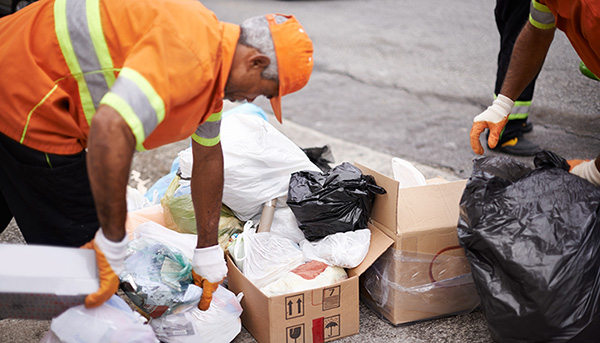Back in 1957, New York City made a decision that sparked a 60+ year downward spiral that has resulted in a near-crisis in 2019. The city stopped collecting commercial trash and forced businesses to hire private carting companies for waste management.
This might not seem like a big deal, but the reality is that this one decision is now impacting nearly 9 million residents. What has often been labeled the greatest city in the world has become one of America’s dirtiest. And it’s largely thanks to a massively inefficient commercial waste management.
As the city takes steps to remedy the situation, it’s important for other cities to take note—now is the time to leverage new technologies and build a smarter sanitation system.
Setting the Scene: NYC’s Waste Management Problem
In a recent Waste360 article, writer Mallory Szczepanski summarizes the disaster that is NYC commercial waste and municipal sanitation. She notes that, “In New York City, more than 100,000 commercial establishments generate upwards of 3 million tons of waste and recycling annually. These materials are collected via approximately 90 private haulers. These haulers, operating primarily at night, can have as many as 1,000 stops to service and cover all five boroughs on a single, long route, while as many as 50 carters may service a single neighborhood.”
In short, it’s a broken system that even the NYC Department of Sanitation calls “inefficient, unsafe and unsustainable.”
The inefficiencies of the system stem from a constant battle among private carters to beat the market. According to a story by The New York Times editorial board:
“New York’s trash nightmare is a model failure of the free market. Commercial sanitation workers contend with dangerous conditions for low pay, and wage theft is rampant. Many routes on this race to the bottom can take upward of 12 hours and cover more than 100 miles, the city report found. By contrast, the longest route of a city sanitation workers is about nine miles, according to city officials, though it often features more stops per mile.”
In addition to further polluting NYC, private carting trucks have injured and even killed pedestrians by ignoring traffic rules in an effort to complete long routes. To remedy this situation, NYC is finalizing legislation that will bring more organization and efficiency to the commercial garbage system. While the latest reforms are a good start as multiple parties have put in significant work to fix this problem, there’s plenty more that can be done to create a smarter waste management system—not just in New York City, but in any city.
3 Keys to a Smart Waste Management Program
“Trash management and disposal is a huge issue in society and figuring out a smarter way to do it in a growing city like New York is a business priority.”—Kathryn Wylde, President of the Partnership for New York City
The new legislation plans to lay out 20 commercial trash zones with a set of private carters to serve each area. According to the Partnership for New York City, these reforms will cut daily private garbage truck traffic from 28 million miles per year to just 11 million by 2024.
But the reality is that route efficiency is just one part of a smarter waste management program. In addition to streamlining the actual paths that private carters take, cities can make an immediate impact on their sanitation and waste management programs by introducing three key smart technologies:
- Smart Containers: You don’t need to spend thousands of dollars – or waste countless manhours – on purchasing and installing new bins all over town. Existing waste containers can be transformed into smart containers quickly and easily by equipping them with IoT devices that contain a small sensor that measures fill levels, orientation and other data points. The small footprint and sophisticated technology of today’s sensors allows them to be placed in any type of container, regardless of their shape, size or their contents.
Driving isn’t the only contributing factor in the amount of time it takes to complete a route. The time spent checking containers that aren’t actually full adds up and can create subtle inefficiencies. With smart containers that take advantage of sensors to accurately measure fill levels, you can improve resource handling to cut costs across your sanitation program.
- Fleet Management: Mapping out efficient routes isn’t just guesswork. Having a centralized platform to gain insight into true daily workloads helps you discover trends and explore new opportunities to increase efficiency. The right platform will offer insights into route accountability, container placement, and zone planning to help optimize resources and drastically reduce maintenance costs.
- Intelligent Routing: Smart waste management goes beyond backend operational efficiencies. Having a mobile app in your garbage trucks will help drivers perform their daily work faster and more efficiently. Instead of giving individual drivers a static route, intelligent routing apps make the process event-driven, sending notifications to nearby drivers when a job is ready.
Best of all, fewer trash haulers on the road means less traffic congestion, fuel consumption and CO2 emissions.
The trash problem in New York City is unique, as the Big Apple is truly one-of-a-kind. But this situation is not so different from other municipalities, many of which have similar issues.
New York sanitation leaders are lucky in one respect: technology is currently available to that can help them today. Smart Waste Collection and waste management solutions are affordable and make a sizeable impact in a matter of weeks.
Check out these success stories to find out how cities like San Francisco reduced overflowing trash cans by 80 percent and saw a 66 percent drop in street cleaning service requests.
